What is diesel fuel algae ?
There are actually different types of diesel algae, aka diesel bacteria. The most common species happily nest right in the space between water and the diesel fuel in your diesel tank. It is not advisable to have water in your diesel tank. However, a lot of boaters encounter water in their tank at some point in their boating careers. Water can enter your tank in different ways and when it does, you run the risk of diesel tank algae wandering in and doing their thing. Diesel algae reproduce by multiplying themselves, so they can rapidly grow in number.
Once they grow in number, you will notice that your diesel fuel will start looking misty instead of bright yellow. When your personal bacteria population is left to grow even more, you will even find brown sludge, flakes or slimy strands in your diesel, e.g. in your primary filter. Often, boaters only notice that they have diesel fuel algae, once they see their engine smoke producing more smoke, dropping in rpm or even just plain stalling (because their filters are clogged). In some cases you might even notice a rotten egg smell coming from your diesel. When in doubt, you can buy bacteria tests, in order to examine if you have diesel algae in your diesel fuel.
Below, you see an example of fairly contaminated diesel fuel. The algae seen here is referred to as ‘biomass’ and ‘bacteria sludge’.
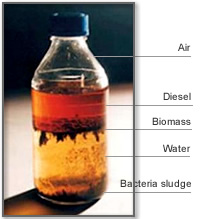
Photo: http://www.oil-analysis.org/fuel_filtration.html
How the heck did that diesel algae get into my tank ?
Some diesel bacteria live in between the diesel and the layer of air in your tank, but most of them do so in between the diesel and water layer in your tank. The bacteria themselves are present in the air all around us. Most of the time they get into your tank through the tank vent. So whenever you not only have diesel, but also water in your tank, you present the diesel bacteria with a nice habitat and so you run the risk of getting a thriving diesel bacteria colony. In addition, water in your diesel causes reduced lubrication of your engine, which results in more wear and tear, as well as your engine running irregularly and therefore reduced performance.
Water can get in your tank in a number of different ways. Here are the most common ones:
– By condensation: a tank is fitted inside the boat. At night (especially in the winter) the tank cools down, while during the day the tank warms up again. The air in the tank also contains a very small amount of water, which then condenses and thus ends up as droplets on the sides of the tank. This water trickles down and then sinks to the bottom of the tank, underneath the diesel (diesel has a lower density than water).
– A badly installed tank vent, e.g. a tank vent that lets rainwater seep through to the tank, or a vent that allows waves splashing against the stern to press water into the tank vent.
– A badly sealing diesel tank filler cap, that lets rainwater or seawater seep through the filler opening.
Diesel algae like hot and humid weather to grow rapidly, but also during the winter they can run go crazy inside your tank.
What are the consequences of diesel bacteria for your marine engine ?
Having diesel bacteria in your tank can be very dangerous for your safety at sea. The bacteria can clog your filters and that, in turn, can cause a drop in rpm or stalling of the engine. And exactly at a time when you’ve had rough weather on the water, the contents of your tank will have been shaken quite a bit. As a result, the sludge from the bacteria will have gotten separated from the bottom of the tank and fom the layer between the water and the diesel fuel. That sludge will have been mixed with the diesel itself, pumped through the diesel filters, thus clogging them and causing your engine to stall, right when you need it the most to make that difficult harbour entrance
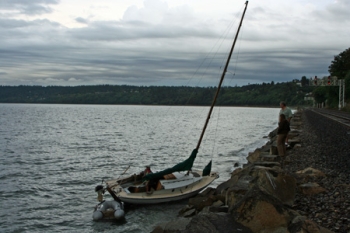
Photo: www.myballard.com
The diesel bacteria can not only cause damage to your diesel filters (which you will usually need to replace), but possibly also to the injectors. It can also cause corrosion of the tank itself and it can affect rubber parts of your fuel system (gaskets, fuel hoses, etc.).
Has diesel changed over the years ? And what about biodiesel ?
Yes, the diesel fuel of today is different from the the diesel fuel of the past:
- In a lot of countries, by law, diesel fuel nowadays should contain less sulfur than before. Burning sulfur is indeed quite damaging to the environment. But on the other hand, sulfur lubricates your engine and diesel bacteria don’t really like a sulfury environment. Darn it !
- Moreover, nowadays, more and more biodiesel is added to the diesel fuel we use. Biodiesel is made from vegetable products and is therefore interesting, because the oil reserves in the world are diminishing. But biodiesel has the chemical property of attracting water, which in turn attracts the diesel bacteria. Darn it again !
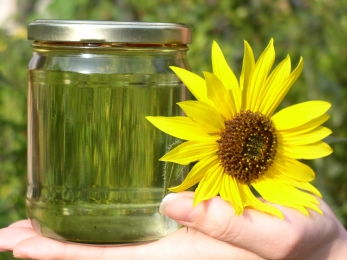
Photo: www.renewablepowernews.com
What can I do about diesel algae ?
A. Prevention
It is essential to keep your tank clean ! You can do this as follows
1. Get high quality diesel in your tank
The diesel you get in western countries is usually of good quality, but beware if you are travelling, more southbound for example (eg in the Mediterranean area, Africa, …). When you buy diesel fuel, try to get an idea of how the diesel is stored at the place where you are getting your diesel. When you can see for example that the gas station stores the diesel in a large diesel tank and you suspect that the tank is rarely used, you run the risk that the diesel is infected. When in doubt, you can always get a little bit of diesel fuel in a separate (see-through) container and take a sample from it. Or you can carry a diesel testing kit on board to be sure.
2. Make sure that as little water as possible gets into your tank
- Check whether your diesel filler closes properly. Make sure you check the rubber seal in the cap !
- Maybe your cap is in a place that systematicallly collects water (eg. in a certain spot in the gangway). In that case, a solution could be to change the location of the filler cap.
- What about the hole of the tank vent? Try to imagine what happens to your vent in different conditions (rising waves, if your boat is heeling towards port or starboard, in rough weather, with waves coming in sideways, …). Is it possible that water is coming in through the vent opening? Maybe the vent is mounted in such a way that rain can just leak in? Or maybe rain only leaks in while heeled towards port? If you think that is the cause, try to find another place for the vent whole. Sometimes it also helps to have a nice gooseneck in the piping of the vent to the tank, so rain can no longer get into the tank itself.
- Always fill your tank completely whey you plan to stop using the boat for a while (eg for the winter). After all, the less space there is at the top or sides of the tank where condense can form, the better.
3. Find ways to detect water in your tank and drain it.
- Install a drain valve or drain plug at the lowest point of your diesel tank.
- Install a primary fuel filter in between your tank and the secondary filter (mounted on the engine itself), make sure that that primary filter has a tap at the lowest point of the filter. An inspection glass at the bottom of the filter is also very useful to see if there is water or sludge in the filter.
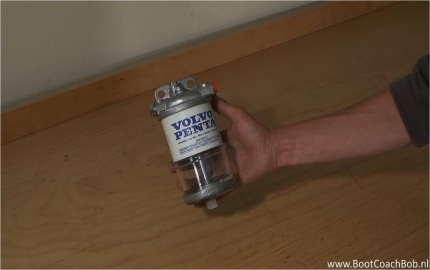
- Every few boating trips, you should drain some diesel from the tank and fuel filter and check whether there is water in it. If so, find the cause. When the diesel is cloudy or looks dirty, you’ll obviously know that something is wrong.
B. The cure: when it all went wrong
There are many products on the market to remove diesel algae (different types of additives for diesel, magnets, …). The only thing at has proven its effectiveness convincingly at this time are biocides. Biocides are chemical substances that specialize in killing bacteria and other organisms. In hospitals for example, biocides are used for disinfection. Some antifoulings contain biocides as well, which obviously kill the fouling on your hull. There is a multitude of biocides available on the market to add to your diesel.
Most of the products you simply need to add to the diesel after your tank has been emptied and thoroughly cleaned. The bacteria often stick firmly to the sides of your tank. Here you see the importance of having an inspection hole in your tank: it gives you the possibility to clean your tank completely by hand when it is necessary. Additionally, you can add the biocides as a precautionary measure each time you refuel.
As an emergency solution you could always have a fresh set of filters on board and a separate container with diesel fuel. If you notice that your filters are very dirty or infested by diesel bactia, you can often still reach the port unharmed with that emergency hose and jerry can.
Want to share your own diesel bacteria story? Do you have other tips? Please add it in the comment section below!
Did you find this article interesting and want more? Like & share it ! Thanks !
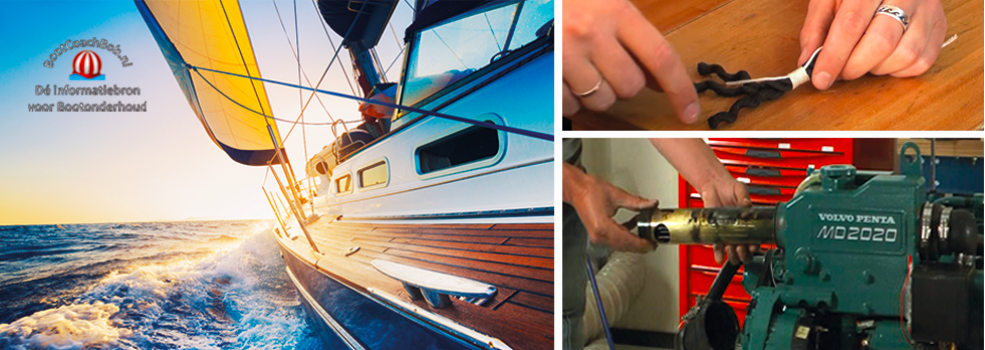
A case of where for an unknown reason, fuel got into the anular space in a tank.
The crew that cleaned it up elected to put the “stuff” into a larger tank so as not to “waste it” assuming it would dilute.
The fuel then had mats of material floating in the larger tank, fortunately reported before fuel was drawn out of the tank.
The oddity is that the fuel does not test bad with the Humbug test kit.
Also I recently found that rather than continue to use the scrudy bucket I use to move bad fuel around (for dispsoal in the right waster tank) it got put my good fuel jugs.
Still testing and getting no response with a call into Humbug rep to see.
Does not appear to propagate, the original batch was bad looking but not badly fouled, just had small amounts of organic gooey stuff (no bigger than a pencil lead end)
Part of it is you can’t ever be too careful and while you think you are dealing with intelligent people, you should always say exactly how you want the item handled (or just do it yourself, its amazing how many gaps in logic the human mind can find in what is supposed to be an intelligent species)
Thanks John for this comment ! I hope you get the algae completely out of your fuel system.
Fair winds,
Meindert